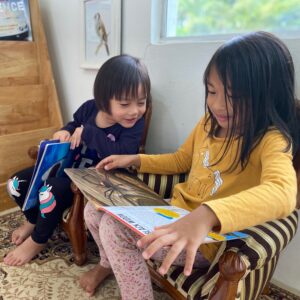In the first three years of life young children have what Maria Montessori described as “the absorbent mind” – one of the amazing things about the absorbent mind is it’s ability to effortlessly absorb languages in the environment without any conscious effort. This is the most crucial time to lay the foundations of multilingualism.
Children remain in what Dr Montessori identified as “the sensitive period for language” up until the age of 6, making this the most crucial time for children to effortlessly acquire multiple languages. During this period from birth, they acquire language spontaneously. After the age of 6, learning another language requires much more conscious effort.
Here are some ways you can support your multi-lingual child the Montessori way:
1) Talk to your child constantly from birth.
Speaking to your child from birth is the first stepping stone towards building language. Through speaking, we give children access to a wide range of sounds and words and build familiarity of language. Always use clear, expressive language & expose them to a wide range of vocabulary early.
The richer your language is with your newborn, the more language they will acquire in their early years. There’s no need to simplify your words or use baby language, your young baby is absorbing every sound & word you make – so use those big expressive words!
2) Use sign language with your infant.
I highly recommend teaching sign language as a way of preparing your child to learn multiple languages.
Teaching your baby to communicate through sign language is an effective way of helping them learn to communicate early. Babies can sign from as young as 4 months, this them to communicate clearly long before they can even speak. It can help eliminate many of the frustrations that occur due to an inability to communicate clearly before words come along.
Introducing your infant to sign language from a young age lays the foundations for a multilingual brain. Sign language can continue to be used alongside spoken language long after spoken language is established.
3) Be consistent in exposing your child to multiple languages.
It is crucial to have consistency & patience when trying to raise a multilingual child. I personally recommend the one parent – one language approach, where each parent speaks to the child in one language exclusively (for example the mother speaks to the child in English and the father speaks only in Malay).
This gives children a fully immersive experience of both languages at once, they will have access to a wide vocabulary in both languages quite quickly, instead of being limited to few words in one language and an extensive vocabulary in the other. This also gives children the opportunity to use (& practise) both of their acquired languages when they converse with each parent.
4) Know that being multilingualism does not cause speech delays.
There is a common misconception that being multilingual can cause speech delays in children, this is not true.
Model the correct use of language and provide your child with exposure to multiple languages from a young age. The absorbent mind is perfectly capable of effortlessly absorbing multiple languages at once.
5) Remember an inability to speak does not mean an inability to understand.
Long before children can speak they absorb words & learn to understand. If your child is not yet speaking in another language but can understand it this is positive progress to build upon. Work on expanding their understanding and allow spoken language to follow naturally.
Focus on building your child’s understanding & vocabulary before introducing letters. Create a language basket : a basket of objects for them to explore & learn the names of the objects. This is an effective way of introducing new vocabulary to children of all ages (including older children). I always recommend the Montessori 3 period lesson technique as a guideline (you can find more about this this on YouTube).
6) It’s never too late to introduce a new language.
You can still help your child become multilingual when they’re older even if you haven’t laid the foundations in the early years. If you wish to introduce a language you are fluent in to an older child, I recommend exclusively switching to speaking that language & sticking to it consistently.
Your child may struggle to understand & communicate at first, they may continue to respond in the language they’re used to you speaking, but through consistency on your part, they will gradually be able to understand & communicate back. Hand gestures or sign language can smooth this transition.




